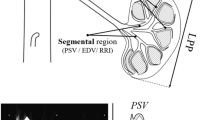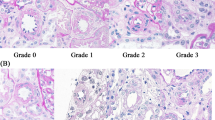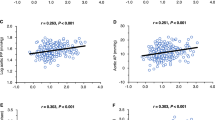Abstract
In essential hypertension, increased renal resistive index (RRI) is associated to a reduction of renal function and microalbuminuria, and to renal tubulo-interstitial damage. A tubulo-interstitial inflammatory infiltration was found in experimental models of hypertension, and serum high-sensitive C-reactive protein (hsCRP) levels correlated with urinary markers of tubulo-interstitial damage in humans. We studied the relationship between RRI and serum hsCRP in hypertensives with preserved renal function, without microalbuminuria. We investigated hypertensive patients without diabetes, renal failure, microalbuminuria or major inflammatory disease. Serum levels of hsCRP were assayed. RRI was calculated by intrarenal Doppler ultrasound and considered pathologic when ⩾0.70 or >95% of upper confidence limit expected for age decade. The renal volume–to–resistive index ratio (RV/RRI) was also calculated. We evaluated 85 patients (57±14 years, 61 males). Patients with pathologic RRI (n=21) were older and had significantly higher hsCRP levels (4.70±2.30 vs 2.93±2.09 mg l−1, P<0.01) compared with patients with normal RRI, as well as patients with decreased RV/RRI (n=43). HsCRP was directly related with RRI (r=0.41, P<0.001) and inversely with RV/RRI (r=−0.35, P<0.001). HsCRP proved to be a significant predictor of both pathologic RRI and decreased RV/RRI, even after adjustment. In essential hypertension low-grade inflammation is associated with tubulo-interstitial damage evaluated by Doppler ultrasonography.
This is a preview of subscription content, access via your institution
Access options
Subscribe to this journal
Receive 12 digital issues and online access to articles
$119.00 per year
only $9.92 per issue
Buy this article
- Purchase on Springer Link
- Instant access to full article PDF
Prices may be subject to local taxes which are calculated during checkout


Similar content being viewed by others
References
King DE, Egan BM, Mainous 3rd AG, Geesey ME . Elevation of C-reactive protein in people with prehypertension. J Clin Hypertens (Greenwich) 2004; 6: 562–568.
Bautista LE . Inflammation, endothelial dysfunction, and the risk of high blood pressure: epidemiologic and biological evidence. J Hum Hypertens 2003; 17: 223–230.
Stuveling EM, Hillege HL, Bakker SJ, Gans RO, De Jong PE, De Zeeuw D . C-reactive protein is associated with renal function abnormalities in a non-diabetic population. Kidney Int 2003; 63: 654–661.
Ruggenenti P, Remuzzi G . Time to abandon microalbuminuria? Kidney Int 2006; 70: 1214–1222.
Pedrinelli R, Dell’Omo G, Di Bello V, Pontremoli R, Mariani M . Microalbuminuria, an integrated marker of cardiovascular risk in essential hypertension. J Hum Hypertens 2002; 16: 79–89.
Festa A, D’Agostino R, Howard G, Mykkänen L, Tracy RP, Haffner SM . Inflammation and microalbuminuria in nondiabetic and type 2 diabetic subjects: the insulin resistance atherosclerosis study. Kidney Int 2000; 58: 1703–1710.
Tsioufis C, Dimitriadis K, Taxiarchou E, Vasiliadou C, Chartzoulakis G, Tousoulis D et al. Diverse associations of microalbuminuria with C-reactive protein, interleukin-18 and soluble CD 40 ligand in male essential hypertensive subjects. Am J Hypertens 2006; 19: 462–466.
Pontremoli R, Viazzi F, Martinoli C, Ravera M, Nicolella C, Berruti V et al. Increased renal resistive index in patients with essential hypertension: a marker of target organ damage. Nephrol Dial Transplant 1999; 14: 360–365.
Galesiæ K, Brkljaciæ B, Sabljar-Matovinoviæ M, Moroviæ-Vergles J, Cvitkoviæ-Kuzmiæ A, Bozikov V . Renal vascular resistance in essential hypertension: duplex-Doppler ultrasonographic evaluation. Angiology 2000; 51: 667–675.
Platt JF, Ellis JH, Rubin JM, DiPietro MA, Sedman AB . Intrarenal arterial Doppler sonography in patients with nonobstructive renal disease: correlation of resistive index with biopsy findings. AJR Am J Roentgenol 1990; 154: 1223–1227.
Sugiura T, Nakamori A, Wada A, Fukuhara Y . Evaluation of tubulointerstitial injury by Doppler ultrasonography in glomerular diseases. Clin Nephrol 2004; 61: 119–126.
Boddi M, Cecioni I, Poggesi L, Fiorentino F, Olianti K, Berardino S et al. Renal resistive index early detects chronic tubulointerstitial nephropathy in normo- and hypertensive patients. Am J Nephrol 2006; 26: 16–21.
Rodriguez-Iturbe B, Romero F, Johnson RJ . Pathophysiological mechanisms of salt-dependent hypertension. Am J Kidney Dis 2007; 50: 655–672.
Rodriguez-Iturbe B, Johnson RJ . Role of inflammatory cells in the kidney in the induction and maintenance of hypertension. Nephrol Dial Transplant 2006; 21: 260–263.
Navarro JF, Mora C, Muros M, García J . Urinary tumour necrosis factor-alpha excretion independently correlates with clinical markers of glomerular and tubulointerstitial injury in type 2 diabetic patients. Nephrol Dial Transplant 2006; 21: 3428–3434.
Ozelsancak R, Torun D, Koc Z, Sezer S, Ozdemir FN, Niron EA . Relationship between renal resistive index and inflammation in untreated hypertensive patients. Int Heart J 2009; 50: 753–761.
Viazzi F, Leoncini G, Ratto E, Falqui V, Parodi A, Conti N et al. Mild hyperuricemia and subclinical renal damage in untreated primary hypertension. Am J Hypertens 2007; 20: 1276–1282.
Mittelstaedt CA . General Ultrasound. Churchill: London, 1992, pp 883–1042.
Boddi M, Sacchi S, Lammel RM, Mohseni R, Serneri GG . Age-related and vasomotor stimuli-induced changes in renal vascular resistance detected by Doppler ultrasound. Am J Hypertens 1996; 9: 461–466.
Boddi M, Abbate R, Chellini B, Giusti B, Solazzo V, Sofi F et al. HCV infection facilitates asymptomatic carotid atherosclerosis: preliminary report of HCV RNA localization in human carotid plaques. Dig Liver Dis 2007; 39 (Suppl 1): S55–S60.
Florczak E, Januszewicz M, Januszewicz A, Prejbisz A, Kaczmarska M, Michałowska I et al. Relationship between renal resistive index and early target organ damage in patients with never-treated essential hypertension. Blood Press 2009; 18: 55–61.
Ishimura E, Nishizawa Y, Kawagishi T, Okuno Y, Kogawa K, Fukumoto S et al. Intrarenal hemodynamic abnormalities in diabetic nephropathy measured by duplex Doppler sonography. Kidney Int 1997; 51: 1920–1927.
Mostbeck GH, Kain R, Mallek R, Derfler K, Walter R, Havelec L et al. Duplex Doppler sonography in renal parenchymal disease. Histopathologic correlation. J Ultrasound Med 1991; 10: 189–194. Erratum in: J Ultrasound Med 1991; 10: 651.
Tublin ME, Bude RO, Platt JF . Review. The resistive index in renal Doppler sonography: where do we stand? AJR Am J Roentgenol 2003; 180: 885–892.
Johnson RJ, Herrera-Acosta J, Schreiner GF, Rodriguez-Iturbe B . Subtle acquired renal injury as a mechanism of salt-sensitive hypertension. N Engl J Med 2002; 346: 913–923.
Murphy ME, Tublin ME . Understanding the Doppler RI: impact of renal arterialdistensibility on the RI in a hydronephrotic ex vivo rabbit kidney model. J Ultrasound Med 2000; 19: 303–314.
Duprez DA, Somasundaram PE, Sigurdsson G, Hoke L, Florea N, Cohn JN . Relationship between C-reactive protein and arterial stiffness in an asymptomatic population. J Hum Hypertens 2005; 19: 515–519.
Mattace-Raso FU, van der Cammen TJ, van der Meer IM, Schalekamp MA, Asmar R, Hofman A et al. C-reactive protein and arterial stiffness in older adults: the Rotterdam Study. Atherosclerosis 2004; 176: 111–116.
Pirro M, Schillaci G, Savarese G, Gemelli F, Vaudo G, Siepi D et al. Low-grade systemic inflammation impairs arterial stiffness in newly diagnosed hypercholesterolaemia. Eur J Clin Invest 2004; 34: 335–341.
Wohlin M, Helmersson J, Sundström J, Arnlöv J, Vessby B, Larsson A et al. Both cyclooxygenase- and cytokine-mediated inflammation are associated with carotid intima-media thickness. Cytokine 2007; 38: 130–136.
Baldassarre D, De Jong A, Amato M, Werba JP, Castelnuovo S, Frigerio B et al. Carotid intima-media thickness and markers of inflammation, endothelial damage and hemostasis. Ann Med 2008; 40: 21–44.
Bots ML, Witteman JC, Hofman A, de Jong PT, Grobbee DE . Low diastolic blood pressure and atherosclerosis in elderly subjects. The Rotterdam study. Arch Intern Med 1996; 156: 843–848.
Ohta Y, Fujii K, Arima H, Matsumura K, Tsuchihashi T, Tokumoto M et al. Increased renal resistive index in atherosclerosis and diabetic nephropathy assessed by Doppler sonography. J Hypertens 2005; 23: 1905–1911.
Okura T, Watanabe S, Miyoshi K, Fukuoka T, Higaki J . Intrarenal and carotid hemodynamics in patients with essential hypertension. Am J Hypertens 2004; 17: 240–244.
Tedesco MA, Natale F, Mocerino R, Tassinario G, Calabrò R . Renal resistive index and cardiovascular organ damage in a large population of hypertensive patients. J Hum Hypertens 2007; 21: 291–296.
Raff U, Schmidt BM, Schwab J, Schwarz TK, Achenbach S, Bär I et al. Renal resistive index in addition to low-grade albuminuria complements screening for target organ damage in therapy-resistant hypertension. J Hypertens 2010; 28: 608–614.
Jabs WJ, Lögering BA, Gerke P, Kreft B, Wolber EM, Klinger MH et al. The kidney as a second site of human C-reactive protein formation in vivo. Eur J Immunol 2003; 33: 152–161.
Parra G, Quiroz Y, Salazar J, Bravo Y, Pons H, Chavez M et al. Experimental induction of salt-sensitive hypertension is associated with lymphocyte proliferative response to HSP70. Kidney Int Suppl 2008; 111: S55–S59.
Buscemi S, Verga S, Batsis JA, Cottone S, Mattina A, Re A et al. Intra-renal hemodynamics and carotid intima-media thickness in the metabolic syndrome. Diabetes Res Clin Pract 2009; 86: 177–185.
Author information
Authors and Affiliations
Corresponding author
Ethics declarations
Competing interests
The authors declare no conflict of interest.
Rights and permissions
About this article
Cite this article
Berni, A., Ciani, E., Bernetti, M. et al. Renal resistive index and low-grade inflammation in patients with essential hypertension. J Hum Hypertens 26, 723–730 (2012). https://doi.org/10.1038/jhh.2011.93
Received:
Revised:
Accepted:
Published:
Issue Date:
DOI: https://doi.org/10.1038/jhh.2011.93
Keywords
This article is cited by
-
Hypertension is Common in Patients with Newly Diagnosed Acromegaly and is Independently Associated with Renal Resistive Index
High Blood Pressure & Cardiovascular Prevention (2019)
-
Diurnal variation of renal resistive index over 24-hour period in hypertensive patients and healthy controls
Abdominal Radiology (2019)
-
Renal resistive index as an indicator of the presence and severity of anemia and its future development in patients with hypertension
BMC Nephrology (2015)
-
The internist and the renal resistive index: truths and doubts
Internal and Emergency Medicine (2015)
-
Mild Hypercholesterolemia Blunts the Proinflammatory and Prothrombotic Effects of Hypertension on the Cerebral Microcirculation
Journal of Cerebral Blood Flow & Metabolism (2013)



